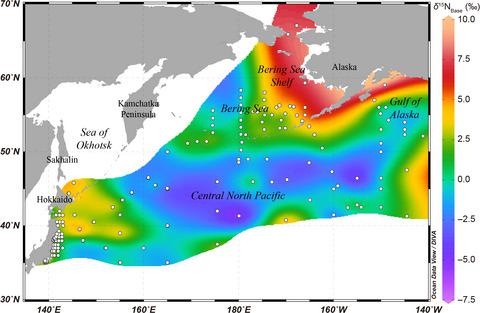当前位置:
X-MOL 学术
›
Ecol. Lett.
›
论文详情
Our official English website, www.x-mol.net, welcomes your
feedback! (Note: you will need to create a separate account there.)
Tracking long‐distance migration of marine fishes using compound‐specific stable isotope analysis of amino acids
Ecology Letters ( IF 7.6 ) Pub Date : 2020-03-24 , DOI: 10.1111/ele.13496 Jun Matsubayashi 1, 2 , Yutaka Osada 1, 3 , Kazuaki Tadokoro 4 , Yoshiyuki Abe 5, 6 , Atsushi Yamaguchi 5 , Kotaro Shirai 6 , Kentaro Honda 7 , Chisato Yoshikawa 2 , Nanako O. Ogawa 2 , Naohiko Ohkouchi 2 , Naoto F. Ishikawa 2 , Toshi Nagata 6 , Hiroomi Miyamoto 4 , Shigeto Nishino 2 , Ichiro Tayasu 1
Ecology Letters ( IF 7.6 ) Pub Date : 2020-03-24 , DOI: 10.1111/ele.13496 Jun Matsubayashi 1, 2 , Yutaka Osada 1, 3 , Kazuaki Tadokoro 4 , Yoshiyuki Abe 5, 6 , Atsushi Yamaguchi 5 , Kotaro Shirai 6 , Kentaro Honda 7 , Chisato Yoshikawa 2 , Nanako O. Ogawa 2 , Naohiko Ohkouchi 2 , Naoto F. Ishikawa 2 , Toshi Nagata 6 , Hiroomi Miyamoto 4 , Shigeto Nishino 2 , Ichiro Tayasu 1
Affiliation

|
The long‐distance migrations by marine fishes are difficult to track by field observation. Here, we propose a new method to track such migrations using stable nitrogen isotopic composition at the base of the food web (δ15NBase), which can be estimated by using compound‐specific isotope analysis. δ15NBase exclusively reflects the δ15N of nitrate in the ocean at a regional scale and is not affected by the trophic position of sampled organisms. In other words, δ15NBase allows for direct comparison of isotope ratios between proxy organisms of the isoscape and the target migratory animal. We initially constructed a δ15NBase isoscape in the northern North Pacific by bulk and compound‐specific isotope analyses of copepods (n = 360 and 24, respectively), and then we determined retrospective δ15NBase values of spawning chum salmon (Oncorhynchus keta) from their vertebral centra (10 sections from each of two salmon). We then estimated the migration routes of chum salmon during their skeletal growth by using a state‐space model. Our isotope tracking method successfully reproduced a known chum salmon migration route between the Okhotsk and Bering seas, and our findings suggest the presence of a new migration route to the Bering Sea Shelf during a later growth stage.
中文翻译:

使用氨基酸的化合物特定稳定同位素分析跟踪海洋鱼类的远距离迁移
海洋鱼类的长距离迁移很难通过现场观察来追踪。这里,我们提出一个新的方法,使用稳定的氮同位素组成的食物网的底部(来跟踪这样的迁移δ 15 Ñ基),其可以通过使用特定的化合物,同位素分析来估计。δ 15 Ñ基地只反映了δ 15在区域尺度硝酸盐在海洋的N和不受采样生物体的营养位置。换句话说,δ 15 Ñ基地可以直接比较isoscape的代用生物与目标移栖动物之间的同位素比率。我们最初构造的δ 15 Ñ基地桡足类的isoscape北部北太平洋通过本体和化合物特异性同位素分析(Ñ = 360和24,分别地),然后我们确定追溯δ 15个Ñ基地产卵鲑鱼的值(虹鳟凯塔)从它们的椎体中央(两个鲑鱼各10个切片)。然后,我们使用状态空间模型估算了鲑的骨骼生长过程中的迁移路径。我们的同位素追踪方法成功地再现了鄂霍次克海和白令海之间密宗鲑鱼的迁移路线,我们的发现表明,在后期的生长阶段,有一条新的迁移路线通往白令海陆架。
更新日期:2020-04-22
中文翻译:

使用氨基酸的化合物特定稳定同位素分析跟踪海洋鱼类的远距离迁移
海洋鱼类的长距离迁移很难通过现场观察来追踪。这里,我们提出一个新的方法,使用稳定的氮同位素组成的食物网的底部(来跟踪这样的迁移δ 15 Ñ基),其可以通过使用特定的化合物,同位素分析来估计。δ 15 Ñ基地只反映了δ 15在区域尺度硝酸盐在海洋的N和不受采样生物体的营养位置。换句话说,δ 15 Ñ基地可以直接比较isoscape的代用生物与目标移栖动物之间的同位素比率。我们最初构造的δ 15 Ñ基地桡足类的isoscape北部北太平洋通过本体和化合物特异性同位素分析(Ñ = 360和24,分别地),然后我们确定追溯δ 15个Ñ基地产卵鲑鱼的值(虹鳟凯塔)从它们的椎体中央(两个鲑鱼各10个切片)。然后,我们使用状态空间模型估算了鲑的骨骼生长过程中的迁移路径。我们的同位素追踪方法成功地再现了鄂霍次克海和白令海之间密宗鲑鱼的迁移路线,我们的发现表明,在后期的生长阶段,有一条新的迁移路线通往白令海陆架。











































 京公网安备 11010802027423号
京公网安备 11010802027423号